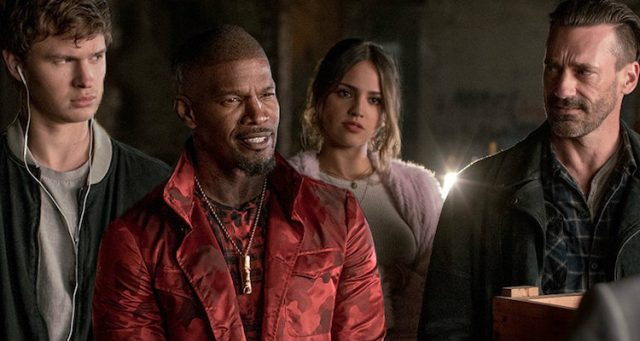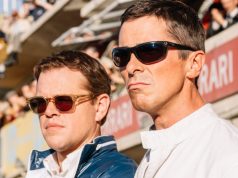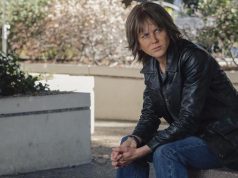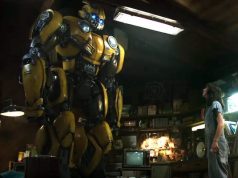
Admittedly, “Baby Driver” employs a gimmick. Written and directed by the impossibly clever Edgar Wright (“Hot Fuzz,” “Scott Pilgrim vs. the World”), the film’s main character is a getaway driver who times his crew’s bank robberies to be in sync with his iPod, which has an eclectic playlist of pop/rock songs that are heard not just in his earbuds but by us, the audience.
“Baby Driver” is thus a musical of sorts, not in the sense of characters bursting into song to express their feelings, but in the sense that the action and dialogue are inextricably linked to a carefully curated selection of tunes. In the bravura opening-credits sequence, our guy struts down the sidewalk to Bob & Earl’s “Harlem Shuffle” as snippets of the lyrics appear “coincidentally” in store windows, graffiti, and posted signs. Elsewhere, you’ll find that gunshots and other sounds are sometimes synched with whatever song is scoring that scene.
I call the use of music a “gimmick” because the film would be significantly less entertaining without it. The story is elementary: Baby (Ansel Elgort), an expert car thief and driver so nicknamed because of his youth and reluctance to speak, works for Doc (Kevin Spacey), a menacingly folksy Atlanta drug kingpin with a revolving cast of miscreants doing robberies for him. Baby meets a diner waitress, Debora (Lily James), who’s lovely and sweet and makes him yearn to escape his life of crime, but first he has to do One Last Job, which, wouldn’t you know it, goes awry. Wright gives the dialogue his usual pep, having fun with gangster cliches (“Here’s Eddie No-Nose, formerly Eddie the Nose”) and giving the characters amusing quirks, but the framework is basic.
Still, if the use of music is a gimmick, it’s a remarkably well-executed one, successfully transforming the familiar material into something buoyant and new. Baby has good reasons, both physical and psychological, for always being plugged into his iPod. He’s aware and unconcerned that it makes his underworld colleagues think he’s being aloof. An orphan, Baby was raised by an old deaf man, Joseph (CJ Jones), with whom he communicates silently. He fell into the criminal lifestyle accidentally and doesn’t have the stomach for it. He’s strictly the driver, not a gunman, and he’s shocked at how casually the gunmen he works with — including a cackling Bonnie-and-Clyde couple, Buddy (Jon Hamm) and Darling (Eiza Gonzalez), and a flat-out psycho named Bats (Jamie Foxx) — perpetrate violence. (It is suggested that these and the other robbers under Doc’s thumb owe him service because of their cocaine habits, which Doc discreetly calls “nasal problems.”)
The contents of Baby’s iPod (iPods, actually; he has several) are often the subject of conversation. Buddy, trying to be his buddy, talks about his own choice for a “killer track” to listen to when you need to be pumped up (Queen’s “Brighton Rock”). Debora wants to hear the T. Rex song that Baby says shares her name (same spelling, even), and they listen together, their toes tapping along with yours. Baby treasures the tape he has of his mother singing to him, in effect reaching from beyond the grave through the power of music. Baby’s tastes run wide and deep; you’ll hear Martha & The Vandellas, The Beach Boys, Dave Brubeck, Sam & Dave, Beck, Blur, Barry White, Danger Mouse, Brenda Holloway, Golden Earring, The Jon Spencer Blues Explosion, The Detroit Emeralds, and a dozen more (including Simon & Garfunkel’s “Baby Driver,” of course*).
As we go jauntily from one plot point to the next, the tension growing as Baby tries to extricate himself from Doc’s employ, Wright meticulously choreographs the action, the editing, and the music for maximum complementary effect — to the point that, in most cases, the song Wright chose feels like the only song that could have worked in that scene. (You could almost believe “Harlem Shuffle” was crafted to match the opening-credits sequence, not the other way around.) A few of the songs are thematically appropriate (“Nowhere to Run,” “Let’s Go Away for Awhile,” “B-A-B-Y”), but nothing too on-the-nose. It’s more about how the songs feel than what messages they contain.
And that’s the movie as a whole, too — focused on creating moods more than conveying ideas, and doing a bang-up job of it. Though the Tarantino-lite story turns violent (how could it not?), Wright avoids wallowing in carnage. He wants us to have fun: to laugh, gasp, and cringe; to grip our armrests during the chase sequences; and to hope for our hero and his girl to get away together. And when it’s over, he wants to send us out of the theater dancing. Mission accomplished!
*I didn’t know Simon & Garfunkel had a song called “Baby Driver” until I saw this movie. I said “of course” because I wanted it to seem like I knew about it all along. I’m a fraud.
B+ (1 hr., 53 min.; )





